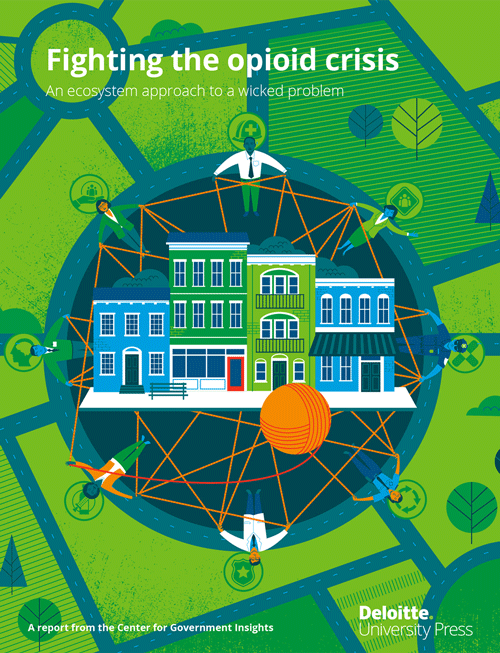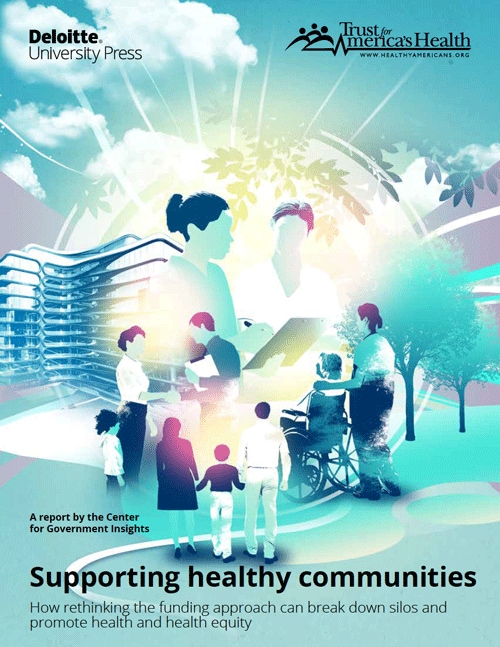
Health care: Improving outcomes, controlling costs The State Policy Road Map: Solutions for the Journey Ahead
07 February 2018
Health care is about more than medical care and is only one factor that contributes to health outcomes. Housing, transportation, nutrition, education, and working conditions play roles. State government agencies need to find solutions to get care providers and community groups working together.
What is the issue?
States have long played a significant role in the health care of their residents, but that role has increased dramatically over the last few years. Under the Affordable Care Act (ACA), millions of poor and low-income people have gained health insurance through Medicaid and the ACA Marketplace.1 Many states are grappling with how to ensure access to quality health care for low-income and vulnerable populations as well as those who buy their own insurance, while at the same time controlling rising premiums and underlying health care costs.
Learn more
View the full collection
Subscribe to receive Public Sector content
View the table of contents and create a custom PDF, or download the full collection
Sign up for the webcast
Alongside these changes, many states are facing an unprecedented opioid crisis, a challenge not only for the health care system, but often also for law enforcement, the child welfare system, and communities at large. Certain parts of the country have been hit particularly hard, but no state is immune to the impacts of this epidemic.2 The crisis is far-reaching, with nearly half of all Americans saying they know someone who has been addicted to prescription painkillers,3 and more than 60 percent saying that federal and state governments aren’t doing enough to fight the problem.4
Against this backdrop of new challenges, many chronic health issues persist, including obesity, diabetes, and mental health conditions. Among the most costly are individuals with multiple chronic conditions—27 percent of Americans have multiple chronic conditions, but a much larger chunk, 66 percent, of total health care spending is directed toward their care.5 There is a growing recognition that many such health issues are strongly linked to socioeconomic factors (for example, income, education, living and working conditions, and numerous other environmental factors) collectively referred to as the social determinants of health.6
These challenges are complex, and each state’s circumstances are unique. But there are numerous strategies that could help states tackle some of their most pressing health care issues.
Issue by the numbers: Health care
- Nationwide, nearly 20 percent of individuals are enrolled in Medicaid—a 29 percent increase since 2014 when the ACA Medicaid expansion provision was implemented.7
- In recent years, Medicaid’s share of state budgets has been on the rise:8
- 11.7 percent in 2001
- 13.3 percent in 2011
- 15.8 percent in 2015
- Following the establishment of the ACA Marketplaces in 2014, states have seen significant variability in annual premium increases. For example, between 2016 and 2017, the average premium change in the Marketplaces ranged from a 4 percent decrease in Indiana to a 145 percent increase in Arizona.9 The White House and Congress continue to consider executive actions and legislation that could impact the Marketplaces. An area of ongoing focus is the federal cost-sharing reduction subsidies (CSRs), which are paid to health insurers to offset deductible and out-of-pocket expenses for low-income individuals who qualify.
- Research shows that social circumstances (including income, education, and living and working conditions) and environmental exposure account for 20 percent of premature deaths. Health care (10 percent), behavioral patterns (40 percent), and genetic disposition (30 percent) account for the remaining 80 percent.10
- Opioids contributed to nearly 34,000 deaths in 2015, and opioid overdoses have quadrupled since 1999.11
How can state leadership tackle the issue?
Consider using waivers to experiment with Medicaid and Marketplace innovations
Most states have at least one Medicaid 1115 demonstration waiver. The purpose of these waivers is to allow states to waive certain federal Medicaid rules and experiment with new policies such as expanding eligibility, providing services not typically covered, and using innovative delivery systems that seek to improve care, increase efficiency, and reduce costs.12
The ACA equivalent of the 1115 waiver is the 1332 state innovation waiver, which became available to states in January 2017. This waiver aims to give states the flexibility to innovate in the health insurance market while retaining the basic protections of the law.13
Bringing a waiver from concept to implementation can be achieved in three phases:
- Strategy. States should align their waiver initiatives with their overall Medicaid goals while also assessing the likely impact the waiver could have on other important areas such as the local economy or the social determinants of health. The strategy phase is also a good time to engage stakeholders and to ensure that the initiative is operationally feasible.
- Design. It is important to develop a structured, planned approach to manage all aspects of waiver initiatives across technology, policy, and human capital; and come up with the best solution against existing infrastructure, policy, and agency operations.
- Implementation: States should provide technical, operational, and policy insight to support implementation. They should also effectively engage, communicate, and train stakeholders affected by the waiver initiative and use technology solutions, where appropriate, to engage members and stakeholders.
To learn more, see Deloitte's study on how states are moving forward with Medicaid and ACA waivers.
When developing policies and proposals for a Medicaid or ACA waiver, it can be useful to see what has and hasn’t worked in other states, while recognizing that each state’s goals and circumstances might differ. And when implementing a change to Medicaid or the Marketplace through a waiver, it is important to rigorously collect data and evaluate results to ensure that good ideas can be replicated.
Explore value-based care (VBC) transformation
The predominant form of health care payment in the United States across public and private payers is fee-for-service,14 in which providers are paid for every consultation, exam, and procedure, regardless of the health outcome. Fee-for-service is often considered inefficient because it incentivizes volume over value.15 A more aspirational goal is to pay less for health care by preventing illness while at the same time improving health outcomes overall.
To learn more, see Deloitte's study on Alternative payment models in Medicaid.
In an effort to transition from a payment model-based volume to one based on value, many states have begun experimenting with a variety of Medicaid alternative payment models (APMs), including patient-centered medical homes (PCMHs), Medicaid health homes, episode-of-care payments, and accountable care organizations (ACOs). Some of these models focus on the coordination of health care services by a team of health professionals to improve health outcomes and avoid unnecessary or harmful redundancies. Others incentivize care teams to improve health outcomes and reduce health care utilization by providing capitated payments to take care of a particular patient with a specific illness.
States that are exploring VBC for their Medicaid program can learn from other states that are already moving down that path. Consider these lessons:
- Know your market. States should consider their unique populations, stakeholders, delivery systems, and political environment when developing a vision for the new program. Design a program that providers and health plans can realistically administer and oversee.
- Keep the program design simple. New payment models can quickly become overbaked and complex. The more complicated the model, the more difficult it will be to implement. Keep it simple at first and, if necessary, introduce more complex components after initial implementation.
- Determine how you will access, aggregate, and analyze data. A VBC program relies on accurate and meaningful data to achieve its goals. New analytic solutions or system upgrades might be needed.
- Expect the unexpected, reflect, and refine. It is important to build time and space into the process to accommodate nuances. Incorporate successes and lessons learned into the program implementation.
Consider using a "healthy community funding hub" to address complex problems
Health care is typically about much more than just medical care. The opioid and broader substance abuse crises, for example, impact not only health care providers, but often also human services, criminal justice, and child welfare. Health care is only one factor that contributes to health outcomes. Various social determinants of health—including housing, transportation, nutrition, education, and working conditions—can also influence well-being.
To tackle these complex problems, disparate agencies, health care providers, and community groups can and should work together. But such groups aren’t necessarily used to communicating, pooling resources, and launching coordinated initiatives. Health care providers and law enforcement might be expending significant resources to address substance abuse and addiction in their communities. But without a coordinated response, they could be duplicating efforts—or worse, working at cross-purposes.
To align strategies and funding, states can work with counties and localities to establish healthy community funding hubs, a concept developed by the non-profit Trust for America's Health (TFAH). The purpose of a healthy community funding hub is to break down the walls between agencies in order to pool funds and other resources, and to develop coordinated responses that impact the community. To that end, the hub would:
- Provide financial management and oversight to coordinate multiple funding sources
- Govern the prioritization of spending on evidence-based interventions to ensure accountability to the target community
- Serve as a trusted fiscal intermediary between sectors that are related to health care
Read more about how human-centered design can improve the citizen experience: |
|
 Fighting the opioid crisis |
 Supporting healthy communities |
Consider updating data systems and developing advanced analytics
Because of Medicaid’s sheer size, states and the federal government are often under tremendous political and economic pressure to ensure that the program is run efficiently and effectively. Doing so through payment and delivery system reform and quality measurement typically requires advanced data capabilities.
For states, the first step toward advancing analytic and data capabilities is likely to upgrade their analytics platform. Legacy systems typically were not built to support the advanced analytics usually required to operate a modern Medicaid program. Many were built based on fee-for-service claims processing operations and didn’t explicitly take tracking processes and outcome measures into account.
As states begin to upgrade their data infrastructure, many are doing so with a broader vision of building an integrated data environment that is interoperable with electronic health records (EHRs) and other agencies and organizations, including social services, public health, and the department of corrections. The federal government has shown its support by offering Medicaid programs a 90 percent contribution to system upgrades that support interoperability, which could advance Medicaid program goals.16
While an upgraded analytics platform might be a necessary first step, it alone won’t allow Medicaid agencies to become data-driven organizations. For that, they’ll likely also need to ensure data quality and adopt self-service capabilities. In other words, agencies should first ensure that their data is accurate, then build software interfaces that can broaden the access and use of the data. Third, collecting the right data and setting clearly defined priorities—be it decreasing emergency room utilization, lowering obesity rates, or reducing the number of diabetes-related hospitalizations—could help deliver results.
To learn more, see Deloitte's study on Organizing for analytics in health care.
Lastly, states should consider establishing a strong analytics team to run the analyses, build effective models, and support the Medicaid operation to drive new payment models, reduce costs, and improve outcomes. Whether a state’s data capabilities are in-house, under contract with an outside vendor, or both, they should ensure they build a capability that can be sustained over the long term.
You don’t need to look too far for inspiration
Minnesota's 1332 state innovation waiver
Minnesota's approved 1332 waiver allows the state to use ACA funds to help establish a reinsurance program designed to reduce the cost of premiums in Minnesota’s ACA Marketplace.17 Prior to the waiver being approved, insurers in the state filed two sets of rates, one under the reinsurance program and the other without one. In the absence of the reinsurance program, health plans intended to increase premium rates by between 3 percent and 32 percent from the previous year. With reinsurance, three out of four Marketplace plans will decrease their rates; one will increase their rate by under 3 percent.18
Oregon’s coordinated care organizations
In 2012, Oregon established 16 coordinated care organizations (CCOs) to serve its Medicaid population through an ACO-like model.19 CCOs consist of networks of providers (physical and behavioral health, and dental care) who work together to serve their patients, and receive capitated payments.
Research funded by the National Institutes of Health (NIH) found that CCOs were associated with a 7 percent relative reduction in service expenditures, attributable primarily to reductions in inpatient utilization, and reductions in avoidable emergency department visits. CCOs also exhibited reductions in primary care visits (a potential area of concern),20 but increases in timely prenatal care.21
Pennsylvania’s adoption of advanced data capabilities
According to federal regulation, states that contract with managed care organizations (MCOs) are required to develop and enforce provider network adequacy standards that include minimum time and distances between beneficiaries and providers.22 Pennsylvania is using advanced data analytics based on geospatial information systems (GIS) to map beneficiaries and providers to determine whether MCOs are complying with federal time and distance requirements and where the gaps need to be filled.23







